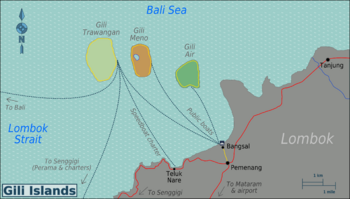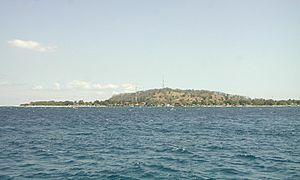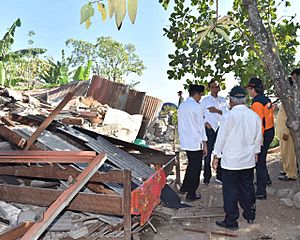Gili Islands facts for kids

Gili Islands and Mount Rinjani in the back
|
|

The Gili Islands, northwest of Lombok
|
|
| Geography | |
|---|---|
| Location | South East Asia |
| Coordinates | 8°21′S 116°04′E / 8.35°S 116.06°E |
| Archipelago | Lesser Sunda Islands |
| Total islands | 3 |
| Major islands | Trawangan, Meno, Air |
| Area | 6.78 km2 (2.62 sq mi) |
| Highest elevation | 60 m (200 ft) |
| Administration | |
|
Indonesia
|
|
| Province | West Nusa Tenggara |
| Demographics | |
| Population | 5,077 estimated permanent inhabitants |
| Pop. density | 748.8 /km2 (1,939.4 /sq mi) |
| Ethnic groups | Balinese, Sasak, Tionghoa-peranakan, Sumbawa people, Flores people, Arab Indonesian |
The Gili Islands (which means "Three Gilis" or "Gili Islands" in Indonesian) are a group of three small islands. They are called Gili Trawangan, Gili Meno, and Gili Air. These islands are located just off the northwest coast of Lombok, Indonesia. Locals sometimes call them Gili Indah, which means "small beautiful islands."
The Gili Islands are a very popular place for tourists to visit. Each island has many places to stay, like small huts, pools, and restaurants. Gili Air has the largest local community. However, Gili Trawangan is more crowded because many people from other countries live there alongside locals. This is especially true on the east side of the island, where most of the tourist spots are.
Cars and motorbikes are not allowed on the islands. People usually walk, ride bicycles, or use a horse-drawn carriage called a cidomo. The islands are also famous for scuba diving and free diving. This is because there is a lot of amazing marine life and beautiful coral reefs. Some well-known diving spots include Shark Point, Manta Point, and Simon's Reef.
Contents
What's in a Name?
The name "Gili Islands" might sound a bit funny because Gili actually means "small island" in the local Sasak language. So, "Gili Islands" basically means "Small Island Islands"! Many small islands around Lombok have "Gili" in their names. To avoid confusion, it's best to use their full names.
The Indonesian word for water is Air. Gili Air got its name because it's the only one of the three islands that has fresh water underground. This fresh water is a limited resource, so some places on the island bring in water from the mainland.
Island Geography and Weather
The Gili Islands are in the Lombok Strait, just northwest of Lombok. They stretch out from a small piece of land called Sire, near the village of Tanjung on Lombok. Bali is about 35 kilometers (22 miles) west of Gili Trawangan, which is the westernmost island. On clear days, you can easily see both Bali and Lombok from the Gilis. Mount Rinjani, Indonesia's second-highest volcano, is close by on Lombok. It offers amazing views to the east.
Because they are close to the Equator, the islands have a warm, tropical climate. They have a dry season and a wet season. With Mount Rinjani to the east and Mount Agung on Bali to the west, the Gilis are a bit protected. They actually have a slightly drier climate compared to other nearby islands. The dry season usually runs from May to October. The monsoon (rainy) season starts in November and lasts until April. Temperatures usually stay between 22°C (72°F) and 34°C (93°F). The average temperature is around 28°C (82°F).
A Look at History
The Gili Islands are small and were settled fairly recently. This means there aren't many old written records about them.
During World War II, Japanese soldiers used the islands as a lookout point and a camp for prisoners. You can still find parts of a bunker on the hill of Gili Trawangan from this time. There's also a sunken patrol boat wreck near Gili Air, which is now a popular dive site. People only started living permanently on the islands in the 1970s. Before that, it was hard to live there because there wasn't much fresh water. These islands used to be untouched mangrove forests, full of wildlife.
At first, Bugis fishermen would stop at the islands during their trips. In 1971, the governor of Lombok started to create coconut farms. He gave land rights to private companies. Some people from a crowded prison in Mataram, Lombok's largest city, were sent to help with the first harvests between 1974 and 1979. Many of these people stayed on the islands and became permanent residents. After problems with the coconut farms, the companies stopped their efforts. The local population grew and started building homes and businesses on the abandoned land. This led to disagreements over land ownership that continue today.
In the 1980s, backpacker tourists began to discover the islands. This happened as tourism grew a lot in nearby Bali. At first, Gili Air became popular because it had more facilities. But Gili Trawangan soon became more popular, mainly because it was closer to better diving spots.
As tourism grew in the late 1980s and early 1990s, the government and land owners became interested in developing the islands again. This led to some local homes and businesses being taken down. However, residents often rebuilt them, showing their strong connection to the islands.
The first place for tourists to stay on Gili Trawangan was a small guesthouse called Pak Majid, built in 1982. In the 1990s, the diving industry grew quickly. The islands became a top place for learning how to dive. This helped tourism grow even more. In the new millennium, more types of places to stay and things to do were built for all kinds of visitors.
In 2000, a group called Gili Eco Trust was started. This non-profit organization helps protect the coral reefs around the islands and teaches people about the environment. They work with local communities and dive shops. They have started many projects to protect and bring back coral reefs, improve waste management, fight against erosion, help animals, and teach people. This was important because the reefs had been damaged by warm ocean temperatures and some fishing methods that were not good for the environment.
Since 2005, fast boats have been running from Bali to the Gili Islands. This has made it much easier for tourists to visit.
Today, the islands are still growing quickly because of tourism. People are working hard to protect the marine life and keep the islands special, different from Bali.
Gili Trawangan
Gili Trawangan, often called Gili T, is the largest of the Gili Islands. It is the only one that rises quite high (30 meters or 98 feet) above sea level. It is 3 kilometers (1.9 miles) long and 2 kilometers (1.2 miles) wide. About 1,500 people live there. The name Trawangan comes from the Indonesian word Terowongan, which means "Tunnel." This is because there was a tunnel built there by the Japanese during World War 2. The Japanese used the higher parts of the island to house anti-aircraft guns. Only the base of these guns remains today.
Gili Trawangan is the most developed of the Gilis and is very focused on tourism. Most of the homes, fun activities, places to stay, and diving businesses are on the eastern side of the island. A local pub, Tír na Nóg, even says that Trawangan is the smallest island in the world with an Irish pub!
On Gili Trawangan (and the other two Gilis), there are no motorized vehicles. People get around by riding bicycles, which locals rent to tourists, or by using cidomo (small horse-drawn carriages). To travel between the Gilis, people usually use motorized boats or speedboats.
Some of the first people to live on Gili Trawangan were fishermen and farmers from Sulawesi. Before people settled there, Gili Trawangan was covered in forest, and deer lived on the island.
The economy of Gili Trawangan mainly relies on tourism. The island is too small for large-scale farming and too far away for big businesses. There is a mosque and a lighthouse on the island.
Challenges of Many Visitors
Since 2009, the number of tourists visiting Gili Trawangan has grown a lot. While this brings many benefits, it can also put a strain on the island's resources and environment. For example, managing waste becomes a big challenge when many people visit. It's important to make sure that waste and water are treated properly to keep the island and the ocean clean. Planning new buildings carefully is also important to protect the island's natural beauty.
Gili Meno
Gili Meno is the middle island of the three Gilis. About 500 people live there, mostly in the center of the island. People on Gili Meno earn money mainly from tourism, coconut farming, and fishing. On the west side of the island, there is a small, shallow lake that produces salt during the dry season. Gili Meno has beautiful swimming beaches all around the island and a special place where sea turtles are protected.
This island attracts fewer tourists than Gili Trawangan. It is the quietest and smallest of the islands. Many couples on their honeymoon like to visit Gili Meno because of its clear water and peaceful, secluded white beaches.
Since early 2017, fresh water has been brought to the island through underwater pipes from Lombok. Electricity also comes from Lombok through underwater cables. Just like the other Gilis, there are no cars or motorbikes on Gili Meno.
Gili Air
Gili Air is the second smallest of the islands and the closest to mainland Lombok. This makes it a popular choice for couples and travelers looking for a quiet getaway. About 1,800 people live there. The island is great for snorkelling and scuba diving off its east coast. You can often see turtles swimming among the coral reefs. Other water sports like Stand Up Paddleboarding and Kitesurfing are also available. An Indonesian cooking school opened near the harbor in 2015. Gili Air also has two public gyms, one indoors and one outdoors on the beach.
More and more money is being invested in tourism on the islands, leading to new resorts and places to stay each year. However, efforts are made to keep each island's unique feel. Gili Air is close to Gili Meno, the smallest and most secluded island, and Gili Trawangan, the largest island known for its many restaurants and parties. This makes Gili Air a good choice if you want a mix of quiet relaxation and easy access to more activities. Both other islands are just a quick boat ride away.
Getting Around
There are no motorized vehicles on the Gili Islands, except for electric scooters. People travel short distances by walking, cycling, or using a Cidomo (horse-drawn carriage). The only way to reach the islands is by sea. Many fast boats operate routes from Bali and Lombok to the Gilis.
- There are direct boat services from Bali and Lombok to the Gili Islands.
- Flights from Ngurah Rai International Airport (DPS) in Bali to Lombok International Airport (LOP) take about 40 minutes. After landing, it's about a 2-hour taxi ride to Bangsal harbor in Northwest Lombok. From there, a local boat takes another 20-30 minutes to reach the Gili Islands.
- Public Ferries leave from Padang Bai (Southeast Bali) every hour. They take about 4–5 hours to reach Lembar (Southwest Lombok). From Lembar, you can take a taxi for a 2-hour drive to Bangsal harbor, where local boats to the Gili Islands wait during daylight hours.
- Fast boats leave daily from Padang Bai (Southeast Bali), Serangan (South Bali), and Amed (North East Bali). The trip usually takes between 1.5 and 2.5 hours.
Earthquake in 2018
In August 2018, a series of strong earthquakes hit Lombok. The first one, on August 5, 2018, had a moment magnitude of 6.9. It caused a lot of damage in North Lombok and also affected nearby Bali. This earthquake caused many injuries and sadly, some deaths.
The Gili Islands were not hit as hard as Lombok, but there was still significant damage to buildings on the islands. Many people who worked in tourism on the Gili Islands lived in Lombok and were greatly affected, losing family members and homes. After the earthquake, it took some time for the Indonesian Government to send help. Local police, military, volunteers, and business owners on the Gili Islands were among the first to respond. They helped get basic supplies like food and clean water, and later helped with temporary shelters. This help was very important in the early days after the disaster, before larger government assistance arrived.
Images for kids
-
View of the west coast of Gili Meno looking south — Lombok is in the distance
-
View of Trawangan Pier and a Cidomo, local transport
See also
 In Spanish: Islas Gili para niños
In Spanish: Islas Gili para niños













